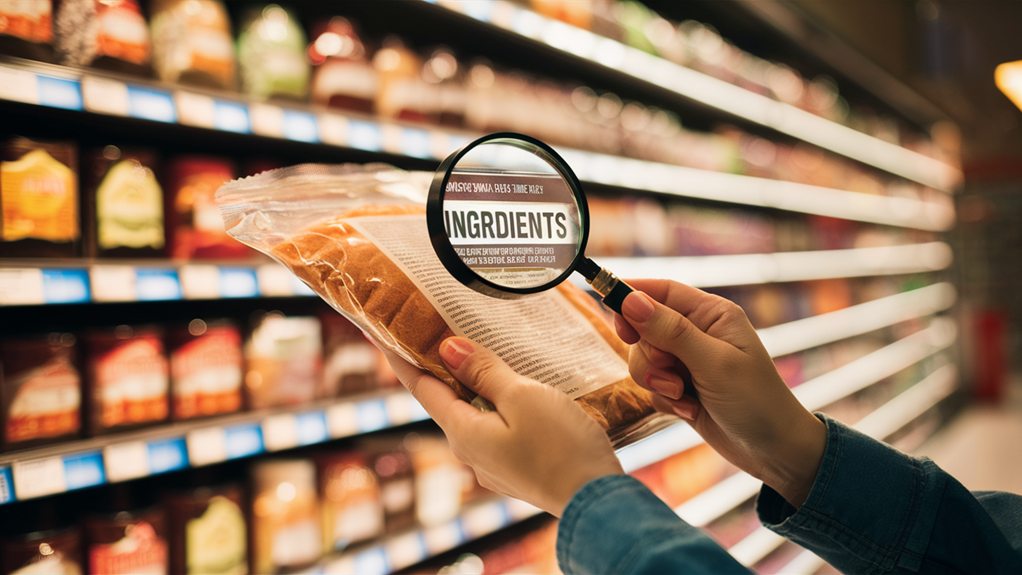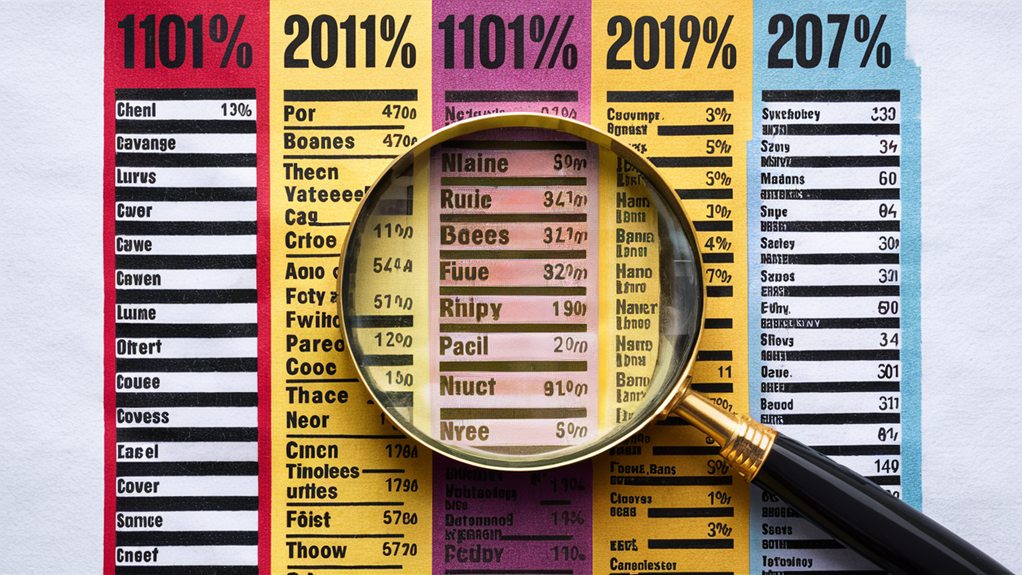When you're learning to read food labels, start by checking the serving size at the top, since all nutritional information is based on that amount. You'll want to identify key nutrients like calories, fats, carbohydrates, and protein, while paying attention to the daily value percentages that show how each serving fits into your daily needs. Look carefully at the ingredient list, which lists items by weight from highest to lowest, and watch out for hidden sugars that might appear under different names. Understanding these basics will help you make smarter food choices, and there's plenty more to discover about making the most of nutrition labels.
Understanding Serving Sizes

When checking food labels, serving sizes form the foundation for all other nutritional information. You'll notice that serving sizes are always listed at the top of the label, and there's a good reason for this placement. Every number you see below it, from calories to vitamins, is based on that single serving size.
Understanding how serving sizes relate to your dietary goals can be particularly helpful when creating balanced meal plans aimed at effective weight loss.
You might be surprised to learn that what you consider a normal portion often differs from the label's serving size. For example, if you're eating a bag of chips that lists a serving size as 15 chips, but you eat 30 chips, you'll need to double all the nutritional values on the label. It's essential to understand this concept, as it directly impacts your daily nutrient intake.
To make the most of serving size information, you should first measure out the exact amount listed on the label. This practice will help you visualize what a true serving looks like and prevent unintentional overeating.
Once you're familiar with proper portions, you can make more informed decisions about your food choices and better track your nutritional intake.
Identifying Key Nutrients
The nutrition facts panel displays several essential nutrients you need to monitor for good health. When you're scanning these nutritional facts, start by checking the total calories, which tell you how much energy you'll get from one serving.
Next, focus on the major nutrients that impact your health the most: total fat, saturated fat, trans fat, cholesterol, and sodium. Choosing whole plant foods over processed options can provide additional health benefits, as whole foods offer more nutrients that support overall well-being.
You'll also want to pay attention to total carbohydrates, which include dietary fiber and sugars. Fiber's especially important because it helps with digestion and keeps you feeling full longer. The protein content's another vital element, as it's essential for building and repairing tissues in your body.
At the bottom of the label, you'll find percentages of vitamins and minerals, like vitamin D, calcium, iron, and potassium.
When you're examining these nutrients, remember that the percentages are based on a 2,000-calorie daily diet. If you eat more or fewer calories, you'll need to adjust these numbers accordingly.
Look for foods that are lower in saturated fats, added sugars, and sodium, while being higher in fiber, vitamins, and minerals.
Decoding Ingredient Lists

Beyond nutritional facts, ingredient lists tell an important story about what's really in your food. When you look at the ingredient list, remember that ingredients are listed by weight, with the most abundant ingredients appearing first. This means if sugar is listed as one of the first three ingredients, you're getting a lot of added sweetness in each serving.
You'll want to scan the ingredient list for red flags, such as artificial colors, preservatives, or multiple types of sugars. Keep in mind that manufacturers often use different names for sugar, like high fructose corn syrup, dextrose, or maltose, which can appear throughout the list.
If you can't pronounce an ingredient or wouldn't find it in your kitchen, it's likely a processed additive. A shorter ingredient list typically indicates a less processed food, while longer lists often mean more artificial additives.
When comparing similar products, choose the one with fewer ingredients and those you recognize. By becoming familiar with ingredient lists, you'll make more informed choices about the foods you eat and better understand what you're putting into your body.
Spotting Hidden Sugars
Countless forms of sugar lurk behind unfamiliar names on food labels, making it challenging to track your total sugar intake. Understanding the impact of these sugars on overall health is vital, especially for athletes who need to optimize their nutrition for performance and recovery.
When you're scanning ingredients during food labeling checks, you'll want to watch for terms ending in "ose," such as fructose, glucose, and maltose, as these are all types of sugar.
You'll also need to look out for natural sweeteners that manufacturers often use as sugar alternatives. These include honey, agave nectar, maple syrup, molasses, and fruit juice concentrates. While they might sound healthier, your body processes them similarly to regular sugar.
Don't forget about less obvious terms like dextrin, barley malt, corn syrup solids, and rice syrup.
To make smart choices, you'll need to add up all these hidden sugars since they're listed separately on labels. Remember that ingredients appear in order of quantity, so if you're seeing multiple forms of sugar in the first few ingredients, that's a red flag.
When you're trying to reduce your sugar intake, it's especially important to check products marketed as "healthy" or "natural," as these often contain surprising amounts of hidden sugars.
For more insights on sugar's effects on athletic performance, check out the truth revealed.
Daily Value Percentages

Understanding Daily Value percentages allows you to quickly assess how a serving of food fits into your recommended daily nutritional needs. When you look at a nutrition label, you'll notice a column showing percentages next to each nutrient, and these numbers tell you what portion of your daily requirements that food provides.
For example, if a food item shows 15% daily value for calcium, it means you're getting 15% of the calcium you need for the entire day from one serving. The percentages are based on a 2,000-calorie daily diet, which serves as a general reference point for most adults.
You'll want to aim for higher daily value percentages in nutrients like fiber, vitamins, and minerals, while keeping an eye on nutrients you might need to limit, such as sodium and saturated fat. A good rule of thumb is to regard 5% or less as low and 20% or more as high.
When you're comparing products, these percentages can help you make smarter choices by showing you which foods pack more nutritional punch per serving.



